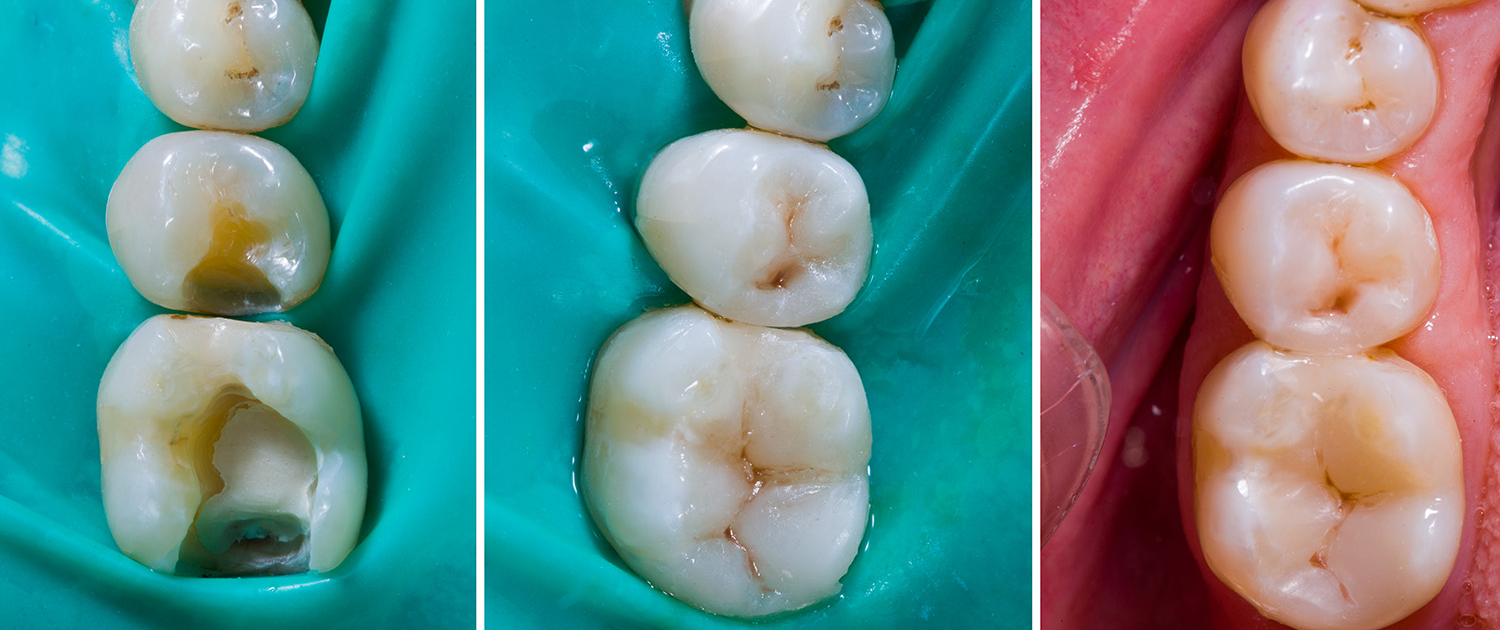Cure caries by filling the tooth
What is a tooth filling?
A tooth filling is a dental technique that aims to restore the body and function of a tooth that has been damaged by caries. Caries penetrates the tooth, destroys the enamel, and forms a cavity. It is worth noting that the presence of a cavity / hole is not necessary as many times, especially in adult patients, the caries is located between two adjacent teeth, in the wall that separates them.
Why should a tooth be filled?
Performing a filling is necessary in order to stop the clinical and microbiological activity of caries. If the caries is not treated, then the inflammation it causes continues deep in the tooth reaching the nerve or pulp of the tooth and causing severe pain or swelling or abscess destroying in some cases completely the tooth itself.
When does a tooth need filling?
Your dentist after a meticulous clinical examination possibly in combination with X-rays will identify the decayed or “damaged” teeth that need treatment. Then, depending on the size of the lesion, the dentist will decide what treatment is appropriate in each case. The smaller the extent of the damage caused, the simpler the treatment will be. Regular screening plays a very important role in the early detection of caries. Do not wait to be in pain to schedule your next appointment at the dentist!
Finally, a tooth may need to be filled after a fracture or in cases of traumatic gingival recessions with revelation of the dentin or when limited aesthetic interventions are performed.
How is a filling done?
First, local anaesthesia is performed so that the whole procedure is as painless as possible. A special isolator called dental dam is then placed so that the area remains as clean as possible (keeping the saliva away) and there is no risk of the patient swallowing liquids or small tools. The dentist then removes the part of the tooth that has been damaged by the caries, cleans this area and after making sure that no carious tissue is left, fills, “seals” the cavity created with a special material. The selection of the appropriate material is based on the depth to which the caries had reached, the position of the tooth inside the mouth (posterior or anterior / aesthetic zone) as well as the existence of allergies on the part of the patient.
Filling materials
The materials currently used to fill decayed teeth are the following:
- Composite resins (white fillings).
- Amalgam (black fillings)
- Glassfibrecement (used mainly for filling of primary teeth).
Composite resin
Composite resinsare the most widely used material for dental fillings.
The composite resin used in dentistry has three main components:
- Organic resin.
- An inorganic filler.
- A coupling agent.
Organic resin
Resin is the chemically active ingredient in the composite. It is initially a monomeric liquid. It is converted to a rigid polymer by an addition reaction. It is this ability to convert from a plastic mass to a rigid solid that allows the material to be used to restore the teeth.
In organic filler
Fillers have been added to composite materials to improve their properties.
The addition of fillers offers significant benefits:
- Shrinkage is reduced, because the amount of resin used is reduced and the filler does not take part in the polymerization process.
- Ceramic fillers have a coefficient of thermal expansion likethe tooth tissue.
- They can improve mechanical properties such as hardness and durability.
- They provide radiolucency, easy to detect on X-rays.
- Fillers are the ideal means of controlling various aesthetic characteristics, such as colour and clarity.
Coupling agent
The composite resin must have acceptable mechanical properties. It is very important that the filler material and the resin are firmly bonded together. If this bond is not strong enough the stresses that develop will not be effectively distributed throughout the material and there will be a high chance of fracture.
Properties of composite resins
1. Handling / operating characteristics
Composite resins are not inherently adhesive to enamel and dentin. Therefore, phosphoric acid etching, and the application of the dentin binder is required.
The correct placement of the restorative material by the dentist but also the careful oral hygiene by the patient are even more important. If secondary caries appears, it tends to evolve faster than other restorative materials.
2. Biocompatibility
Composite resins, as well as the various components and decomposition products released from these materials,are complex structures.
However, this should not be construed as a risk to the patient. The amount of decomposition products released is very small. Hypersensitivity reactions associated with composite resins are rare.
3. Water absorption
Water absorption should be maintained at a low level. Excessive water absorption has a detrimental effect on the colour fastness and wear resistance of the material.
If the composite resin can absorb water, then it is also able to absorb other fluids from the oral cavity, which can lead to discoloration.
4. Coefficient of thermal expansion
The stresses that develop due to differential expansion and contraction must be minimized. The coefficient of thermal expansion of the composite material must be as close as possible to that of the tooth tissue. The bonding materials have a low coefficient of expansion. The resins have a high coefficient. Thus, the higher the content of the inorganic filler the lower the coefficient of expansion
5. radiolucency
When composites are used as a restorative material on the back teeth, their radiolucency is of the utmost importance. Detection of caries under a non-radiant material is impossible and will allow the caries extension process to go unnoticed for a long time.
6. Aesthetic result
7. Resistance
8. Hardness
Amalgam
Dental amalgam is an alloy of pure mercury with silver, tin, copper, zinc, or other metals, precious or not, and is used to fill dental cavities. These are what we call black fillings. Essentially, dental amalgam is the solidification of liquid mercury. From a liquid that is at room temperature it is converted to a solid after mixing various metals.
Dental amalgam is one of the most controversial dental materials. The first amalgam fillings were made in Paris by Traveau in 1826 and were called “silver paste”.
Today, after a thorough analysis of scientific data, amalgam fillings have been banned in people under the age of 16, pregnant women and breastfeeding women. Many European countries have widely banned amalgam for the entire population, while in others, including Greece, its use is allowed only in those clinical cases where the dentist deems it necessary.

